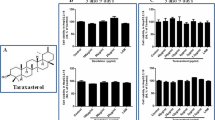Abstract
The gene encoding MAP30 protein was cloned from bitter melon and recombinant MAP30 was expressed and purified. The human hepatoma G2.2.15 cells were exposed to different concentrations of MAP30. MTT assay was used to evaluate the cytotoxicity of the drugs and real-time PCR and Southern hybridization were applied to quantify extracellular HBV DNA and replicative intermediates intracellular and cccDNA in nucleus. HBsAg and HBeAg were assessed by enzyme-linked immunosorbent assay (ELISA). The results showed that exposure of HepG2.2.15 cells to MAP30 resulted in inhibition of HBV DNA replication and HBsAg secretion. After exposed to three different concentrations of MAP30 for 2, 4, 6, and 8 days respectively, the inhibition rates of extracellular HBV DNA, HBsAg, and HBeAg of each concentration decreased significantly (P < 0.05). After 9 days of treatment, the inhibition rates of extracellular HBV DNA of the different concentrations differed greatly (P < 0.001). The MAP30 could inhibit the production of HBV (P < 0.01) dose-dependently. The expression of HBsAg was significantly decreased by MAP30 dose-dependently (P < 0.001) and time-dependently (P < 0.001). Lower dose of MAP30 (8.0 μg/ml) could inhibit the expression of HBsAg and HBeAg.





Similar content being viewed by others
References
Fleming J (2002) Current treatments for hepatitis. J Infus Nurs 25:379–382
Elsaadany S, Tepper M, Mao Y, Semenciw R, Giulivi A (2002) An epidemiologic study of hepatocellular carcinoma in Canada. Can J Public Health 93:443–446
Hassan MM, Hwang LY, Hatten CJ, Swaim M, Li D, Abbruzzese JL, Beasley P, Patt YZ (2002) Risk factors for hepatocellular carcinoma: synergism of alcohol with viral hepatitis and diabetes mellitus. Hepatology 36:1206–1213
Torbenson M, Thomas DL (2002) Occult hepatitis B. Lancet Infect Dis 2:479–486
Hino O, Kajino K, Umeda T, Arakawa Y (2002) Understanding the hypercarcinogenic state in chronic hepatitis: a clue to the prevention of human hepatocellular carcinoma. J Gastroenterol 37:883–887
Esteban R (2002) Management of chronic hepatitis B: an overview. Semin Liver Dis 22(Suppl 1):1–6
Mazumdar TN (2001) Management of chronic hepatitis B infection: an update. J Indian Med Assoc 99:306–308
Ganem D, Varmus HE (1987) The molecular biology of the hepatitis B viruses. Annu Rev Biochem 56:651–693
Wai CT, Chu CJ, Hussain M, Lok AS (2006) HBV genotype B is associated with better response to interferon therapy in HBeAg(+) chronic hepatitis than genotype C. Hepatology 36:1425–1430
Manns MP (2002) Current state of interferon therapy in the treatment of chronic hepatitis B. Semin Liver Dis 22(Suppl 1):7–14
Shindo M, Hamada K, Koya S, Sokawa Y, Okuno T (1999) The clinical significance of core promoter and precore mutations during the natural course and interferon therapy in patients with chronic hepatitis B. Am J Gastroenterol 94:2237–2245
Liaw YF (2002) Therapy of chronic hepatitis B: current challenges and opportunities. J Viral Hepat 9:393–399
Wolters LM, Hansen BE, Niesters HG, de Man RA (2002) Viral dynamics in chronic hepatitis B patients treated with lamivudine, lamivudine-famciclovir or lamivudineganciclovir. Eur J Gastroenterol Hepatol 14:1007–1011
Chiou HC, Lucas MA, Coffin CC, Banaszczyk MG, Lollo CP (2001) Gene therapy strategies for the treatment of chronic viral hepatitis. Expert Opin Biol Ther 1:629–639
Lee-Huang S, Huang PL, Huang PL (1995) Inhibition of the integrase of human immunodeficiency virus (HIV) type 1 by anti-HIV plant proteins MAP30 and GAP31[J]. Proc Natl Acad Sci U S A 92(19):8818–8822
Lee-Huang S, Huang PL, Chen HC, Huang PL, Bourinbaiar A, Huang HI, Kung HF (1995) Anti-HIV and anti-tumor activities of recombinant MAP30 from bitter melon. Gene 161(2):151–156
Zarling DA, Calhoun CJ, Feuerstein BG, Sena EP (1990) Cytoplasmic microinjection of immunoglobulin Gs recognizing RNA helices inhibits human cell growth. J Mol Biol 211(1):147–160
Tumer NE, Hwang DJ, Bonness M (1997) C-terminal deletion mutant of pokeweed antiviral protein inhibits viral infection but does not depurinate host ribosomes. Proc Natl Acad Sci U S A 94(8):3866–3871
Lee-Huang S, Huang PL, Nara PL, Chen HC, Kung HF, Huang P, Huang HI, Huang PL (1990) MAP 30: a new inhibitor of HIV-1 infection and replication. FEBS Lett 272(1–2):12–18
Joyeux A, Cavaillès V, Balaguer P, Nicolas JC (1997) RIP 140 enhances nuclear receptor-dependent transcription in vivo in yeast. Mol Endocrinol 11(2):193–202
Grever MR, Schepartz SA, Chabner BA (1992) The National Cancer Institute: cancer drug discovery and development program. Semin Oncol 19(6):622–638
Garson JA, Grant PR, Ayliffe U, Ferns RB, Tedder RS (2005) Real-time PCR quantitation of hepatitis B virus DNA using automated sample preparation and murine cytomegalovirus internal control. J Virol Methods 126(1–2):207–213
von Weizsacker F, Kock J, Wieland S, Offensperger WB, Blum HE (1990) Dominant negative mutants of the duck hepatitis B virus core protein interfere with RNA pregenome packaging and viral DNA synthesis. Hepatology 30:308–315
von Weizsacker F, Wieland S, Kock J, Offensperger WB, Offensperger S, Moradpour D, Blum HE (1997) Gene therapy for chronic viral hepatitis: ribozymes, antisense oligonucleotides, and dominant negative mutants. Hepatology 26:251–255
Chu CK, Boudinot FD, Peek SF, Hong JH, Choi Y, Korba BE, Gerin JL, Cote PJ, Tennant BC, Cheng YC (1998) Preclinical investigation of L-FMAU as an anti-hepatitis B virus agent. Antivir Ther 3:113–121
Colacino JM (1996) Mechanisms for the anti-hepatitis B virus activity and mitochondrial toxicity of fialuridine (FIAU). Antiviral Res 29:125–139
Pollicino TL, Belloni G, Raffa N, Pediconi G, Squadrito G, Raimondo Levrero M (2006) Hepatitis B virus replication is regulated by the acetylation status of hepatitis B virus cccDNA-bound H3 and H4 histones. Gastroenterology 130(3):823–837
Author information
Authors and Affiliations
Corresponding author
Rights and permissions
About this article
Cite this article
Fan, J.M., Zhang, Q., Xu, J. et al. Inhibition on Hepatitis B virus in vitro of recombinant MAP30 from bitter melon. Mol Biol Rep 36, 381–388 (2009). https://doi.org/10.1007/s11033-007-9191-2
Received:
Accepted:
Published:
Issue Date:
DOI: https://doi.org/10.1007/s11033-007-9191-2




